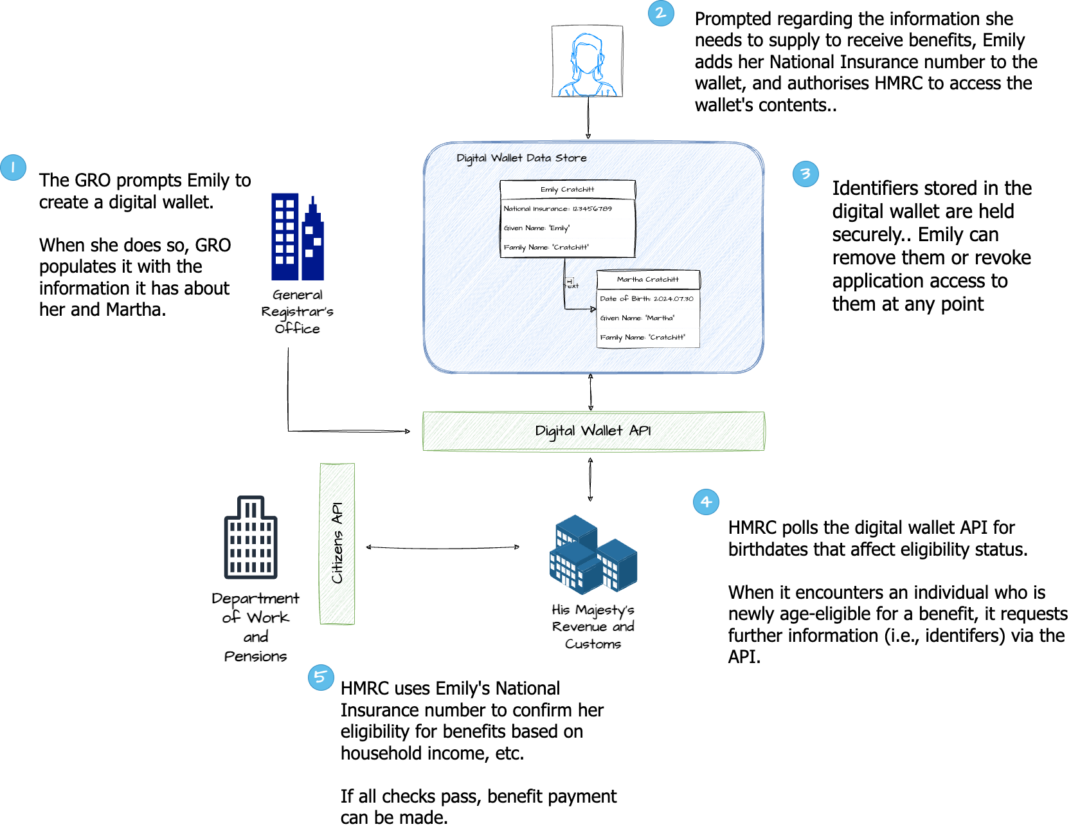Connecting the data dots: how government can proactively support working parents

The key to building a proactive state is data access. Not just what data is shared, but also how
Before the election, Harry and I wrote about what a proactive state could look like for working parents. We looked at how government could simplify access to support. And crucially, we explored how this could transform the lives of families with hardworking parents who are currently missing out on what they’re entitled to.
I wanted to dig deeper into understanding what it would take to ‘connect the dots between […] data points to proactively provide support for families’, so I spoke to dxw Lead Technologist Timothy Hill to get his perspective. This blog post sums up some of his thoughts, along with my experience from working on the digital identity programme at GDS. Warning: things get a bit ‘techy’.
The key to building a proactive state is data access. Not just what data is shared, but also how. At present, citizen data is siloed in departments. This is why you might find yourself submitting a tax return to HMRC and then, a few weeks later, having to tell DWP how much you’ve earned in order for them to assess your eligibility for benefits.
Support for families relies on data collected by government departments:
- Telling the GRO that a child has been born
- Parental income data collected by HMRC
- Receipt of Universal Credit managed by DWP.
Each of these departments have existing APIs to enable this data to be shared. This is great news. We could use this data as follows:
- GRO match the child’s name to the parent(s) name
- GRO and HMRC matches a National Insurance (NI) number for the parent(s)
- The NI number references DWP records
- A whole picture is formed and benefits are delivered.
But in practice, there are significant broken links in the chain. The very first link is especially fragile, from the parent name to NI number. Names are not normally unique, so they aren’t really usable as identifiers on a national scale. If there’s no NI number, then, the trail runs cold.
How can we get around this?
In many other countries, ID cards form the basis for a single, unified and validated identity. However, we don’t have these in the UK. We also know that there is strong public and political sentiment against ID cards. This route is commonly seen as a non-starter. It’s also not strictly necessary.
But we do need a way to map all identifiers to each other. It has to be something that relates a name to a passport number to an NI number unambiguously. It must also be incredibly secure and respect data privacy.
One way of thinking about this is as a simple ‘digital wallet’. Implementations of digital wallets vary broadly, from platforms aimed chiefly at payments (e.g. Google Wallet) to mobile-centred identity systems such as the EU’s recently-mandated eIDAS technology.
Our needs are less ambitious. We need a system that allows us to ‘push’ child-related benefits to families, rather than waiting for them to actively ‘pull’ from it. For this, all we need is a digital space, or ‘wallet’, that:
- Stores nothing but relevant government identifiers
- Gives the end user (citizen) full control over which identifiers are stored
- Can be accessed by outside organisations explicitly authorised to do so by the user
- Obeys a ‘minimal sharing’ principle, whereby only a bare minimum of information is returned
How would a digital wallet work?
Returning to support for families, let’s walk through the digital wallet in practice.
- A child is born, let’s call her ‘Martha Cratchit’
- When parent ‘Emily Cratchit’ registers the birth, she is invited to create an account with the wallet service and made aware of the information she needs to provide in order to secure support – contact details, National Insurance number, or alternative identifiers
- An additional wallet is created for Martha, managed via Emily’s account
- Martha’s wallet contains only her date of birth and her names.
- Emily consents to storage of each of these data points, and can manage who the details are shared with
- The contents of this digital wallet can be accessed by the organisations to which Emily has consented to share (part of) her data.
We now have all the links we need to establish eligibility for support: Martha’s account is associated with Emily’s account; Emily’s account is associated with the necessary identifiers that allow HMRC and DWP to find out details of household income and any other information related to eligibility.
So, let’s set up a “Push Childcare Benefits” (PushCB) service within HMRC, as they’re ultimately the ones responsible for paying the benefits. But how is this service triggered? How does HMRC know what type of support, and how much support Emily is eligible to receive?
There are several good infrastructural patterns for automated communication between different systems. We need our system to be quite robust – for instance, PushCB needs to be alerted in the event that it can’t contact the wallet service, or if it doesn’t have appropriate permissions to retrieve the information needed from it. Accordingly, we’ll stick with REST APIs for communication. If we want to know when Martha is eligible for 15 free hours of childcare, PushCB will simply poll the wallet for DOB = 9 months < NOW < 2 years
Once we know when Martha turns 9 months old, PushCB launches query to retrieve just the data needed to determine what benefits to push:
- Contact details
- HMRC identifier(s)
- DWP identifier(s)
Using this info, PushCB:
- Queries HMRC datastores for income and household information
- Queries DWP Citizen API for other information related to eligibility
- Applies business rules to income data from HMRC’s own datastores and benefits data from HMRC
- Notifies Emily of her eligibility status as appropriate
In overview, the process as a whole looks a bit like this:

With this infrastructure in place, we can now extend the different use cases and applications. For instance, we could query NOW – 18 years, and automatically notify Emily of her right to vote, without necessarily accessing anything beyond contact details.
This is achievable.
Yet, it goes without saying that any team taking on this challenge will need to understand and be cautious of the complexities around data. How data is managed, secured, shared and the standards to adhere to. Legislation may need to catch up with technology. People will need support to understand how and why their data is used and managed. Government teams will need to be capable of (and have the capacity to support) good communication and governance. There are a whole host of issues to consider here: security in data exchange; trust in data exchange. Both of these topics are far too large to get into here.
The example we have outlined here is just one possibility of many ways the government can begin to ‘connect the dots’. Recent changes to the structure of digital in government have potential to create new opportunities for this type of collaborative transformation. As technologists, we’re watching closely to see what happens next.
The UK is tantalisingly close to building the proactive state. But we’re not there yet. It’s going to take coordination between citizens, politicians, legislators and – crucially – digital infrastructure to make this vision a reality.